Garden of trust exhibition
Visual correspondence between Gluklya and Kati Horna
GALLLERIAPIÙ Via del Porto 48 a/b, 40122 Bologna (Italy) | +390516449537|info@gallleriapiu.com|www.gallleriapiu.com
opening 26/02/2022
27/02 > 30/04/2022
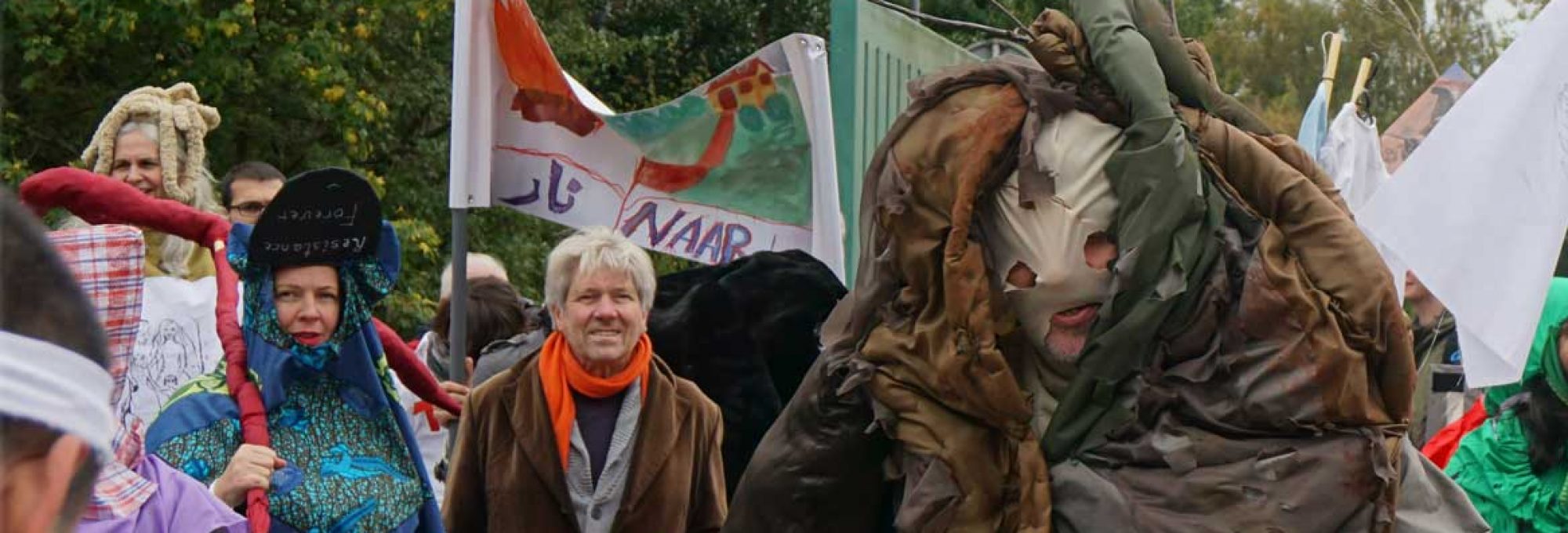
Natalia Pershina-Yakimanskaya
Visual correspondence between Gluklya and Kati Horna
GALLLERIAPIÙ Via del Porto 48 a/b, 40122 Bologna (Italy) | +390516449537|info@gallleriapiu.com|www.gallleriapiu.com
opening 26/02/2022
27/02 > 30/04/2022
Peaceful Dress joined the Protest against the War in Ukraine
28 February 2022
Amsterdam , Dam square
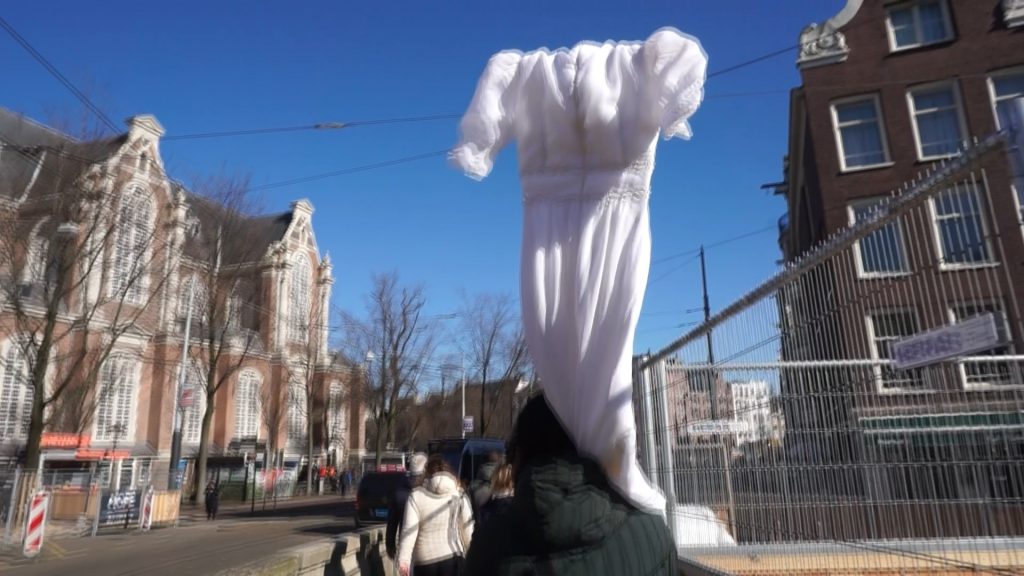
Red Dress Congress as part of Space 1520, an artistic research laboratory at GARAGE Museum of Contemporary Art /Moscow /2021-22
“Dream/Bed”, series for Mn Artists program of the Walker Art Centre, Minneapolis MN USA, https://mnartists.walkerart.org/
Gluklya: https://mnartists.walkerart.org/letters-to-the-doctor
Date:
4 Dec 2021–13 Mar 2022
Place:
GES-2
https://v-a-c.org/en/ges2/when-gondola-engines-were-taken-to-bits-exhibition
ACC Gallery Weimar, Germany,
2021/2022
A brief introduction
Defamation as an instrument of social control with unaccountable consequences seems to have been always present. As a communication strategy, it often serves to exclude individuals, makes society and individuals ill, bears the traits of a passion. Yet it appears to be an anthropological given, closely linked with curiosity, rumor, gossip, and betrayal. So we, too, are at risk, because a particular criminal energy is not required for defamation – in times of digital networks, it is even tempting and easier for everyone, and the transition from inconspicuous ordinary citizen to the defamator is fluid. We are apparently seduced into defamation by a heightened need for aroused sense of control and aroused desire for power, in short a potential, a block-warden-mentality that is potentially dormant in us. Non-political backgrounds are often the cause of ‘common’ defamation, rather hidden private motives such as envy, resentment, bitterness, feelings of revenge and jealousy play an important role. If one can exert little influence in any other way, he or she might try to get rid of a competitor or to exercise power over a superior by making a false (anonymous) statement. The feeling of being of influence seems to some so appealing that moral considerations are superseded. At the same time, different social environments produce different patterns of defamatory behavior, ranging from personal favoritism to state domination and combinations of both. It is possible that the tendency to defamation is particularly high in times of diffuse political insecurity. Its effectiveness also depends on the prevailing norms and social conditions. An ethic of dealing with our information behavior and its consequences is unavoidable, because, just as there are reports that are ethically required or reports to the state or institutions are necessary, other reports can be devastating for the individual. As is known, the victims of defamation as a ‘weapon’ often suffer from vehemently damaged trust; they have not infrequently paid with their lives.
In an upcoming international group exhibition, eight to ten artists will show works that explore defamatory behavior and examine various aspects of defamation, works that deal with specific cases of defamation, its history, the psychology of the defamator and the victim, defamation techniques and language use, the role of (mass-)media and social networks, the role of anonymity, and so on.
About the Language of Fragility, the concept of Gluklya is described by Sari Akminas (a syrian refugee, a journalist, who works at Lola Lik):
Learning the Dutch language is a serious challenge for newcomers to the Netherlands. There are many methods and ways to learn a new language, other than traditional learning, which can give added value to the language learning process. One alternative method is by playing the Language of Fragility game. No matter what language is spoken, the number of words that have similar pronunciation in a native language and Dutch is surprising. Words sound the same, but have completely different meanings.
This game can be an important tool for newcomers. It allows them to acquire new knowledge, motivates them to search and find similar words between different languages, opens a window for them to see the country’s culture, and finds opportunities to learn new skills.
The combination of language + arts, gives newcomers a way to express feelings in a new country without restriction, and to produce something of beneficial artistic and cultural value. By engaging in a workshop of making Utopian Clothes, the Language of Fragility teaches performative skills that enable participants to express emotional feelings; be it frustration, fear by targeting these emotions and in turn, finding balance and self-confidence.
Language of Fragility is not limited to the individual level. Participants learn words that have similar pronunciation, but disparate meanings in different languages. The game encourages players to create an atmosphere of partnership and unity among themselves, motivating them to participate in teamwork and to unleash imagination in creativity and self-discovery.
Naar(fire)
Dutch people use the word (Naar) to refer to a place they are going to, but in Arabic, the word (Naar) means fire.
The woman is going Naar the fire, to the house, where woman leave it to their husband house, because of the suppression and dianilation that the women are facing in the Arab world. A lot of women don’t know the life outside the house, only on TV.
From her father’s house to her husband’s house to the grave. This is the circle of a large number of the women in the Arab world, they are not allowed to know or to think outside this triangle, and for those who does, they shall be called in the ugliest titles, and yet to be considered as an outsider of the society.
____________
Boot\ Boot (military shoe)
Boot is the bone that the dog catches, and they keep it in their mouses, they like the taste of it.
(Boot) in Arabic means shose, and it is commonly refer to the military shoes, which are in Syria are being bitted at like the dogs bits the bone by the pro Assad people in Syria.
People using non intellectual ways to express their loyalty to the rulers, in Syria, the pro Assad took the military shoes as a symbol. They made statues in the public squares for it, live show on tv with the shoes on the table, pro Assad people, famous artists, sculpture, actors, they were all shown with this slogan (one of them was kissing it) on TV and in public events.
It is another way to worship the leader; since the war in Syria, a lot of talk took place about the ownership of Syria to Assad, as the country is his farm. Now by changing from worshiping the leader, into worshiping the military (where the ruler is the higher commander of the army) nothing will change, and the people, voluntarily subject themselves to the slavery of the ruler again.
——————————
Nmer (tiger)
Nmer in Arabic is tiger, but in Dutch, Nummer is a number.
Numbers are exactly how the government see the people when they are looking for support.
The soldiers who die to keep the ruler in chair are only numbers to the leadership.
When they tell people how good the economy is, where actually it is very bad, fake numbers are being used.
So stop being a “dutch Nummer”, and became an “Arabic NAcht \ اخت
Acht (sister)
Two words similar in pronunciations, Acht in Arabic means sister, while in Dutch means eight, which is the average number of the sisters and brothers in the Arab region families.
“The kid come, and God send his money with it” This is the slogan adopted by the peoples of the Arab region, and they do not give up this slogan even in the most severe crises. You see a family of a government employee who doesn’t earn enough salary, or a worker who earns the minimum wage. They have six children and their poor wives are Pregnant! “Her belly reaches her chin” this is how Arab people describe pregnant women.
Ask the men why? And from where will you secure the budget? they responds with a smile to “The kid come, and God send his money with it” and wishe God to send more bless…
Sister behind brother, behind sister… Arab women are being used as a breathing machine, year after year, born after the other, especially in the poor tribal and rural areas, and then leaves the children in the streets, to learn begging, so we ended up with a whole generation in the streets.
The government is unable to control the issue, or issue a birth control law, a poor economic situation and men who do not use condoms, women can not object. Eggs hatch to the streets… Acht after Acht after Acht…
Boot\ Boot (military shoe)
Boot is the bone that the dog catches, and they keep it in their mouses, they like the taste of it.
(Boot) in Arabic means shose, and it is commonly refer to the military shoes, which are in Syria are being bitted at like the dogs bits the bone by the pro Assad people in Syria.
People using non intellectual ways to express their loyalty to the rulers, in Syria, the pro Assad took the military shoes as a symbol. They made statues in the public squares for it, live show on tv with the shoes on the table, pro Assad people, famous artists, sculpture, actors, they were all shown with this slogan (one of them was kissing it) on TV and in public events.
It is another way to worship the leader; since the war in Syria, a lot of talks took place about the ownership of Syria to Assad, as the country is his farm. Now by changing from worshiping the leader, into worshiping the military (where the ruler is the higher commander of the army), nothing will change. The people voluntarily subject themselves to the slavery of the ruler again.
March 2022
McKinney visiting artist to the Eskenazi School of Art, Architecture, and Design
Indiana University – Bloomington
zoom artist talk and graduate studio visits
Dear people!
Today we are celebrating the finalisation of our first serial of lab sessions within the Gluklya project CLINIC OF MULTIPLICITIES with members from Matras Platform. We were writing on mattresses on the streets of Amsterdam working with the questions which were raised during our conversations. We are doing it at 3 pm in Vondel park because the same time it is a Protest Demonstration will start at Pieter Calandlaan 1-In solidarity with the victims of the event that was happened in AZC Echt on 21 April 2021.
Welcome to join us with the amazing present of doctor Marianne Koemanand doctor Yulia Ratman
Today our generalisation questions are :
How we can turn the disciplinary rules and distance into a positive flow, by embracing the synchronisation in TIME?
How we can embrace the TIME by synchronising it with the Distance?
Can we stay united by synchronisation of actions at the same TIME?
Welcome to choose the Care Walk by silent way or with talking.!
Dying to see you during the slot of time 3 -5 pm in Vondel park near Blau cafe at the bike place. Veel Kusjies,hartelijke .
The Monument of Modern Slavery
I am contributing to the exhibition disturbance: witch, curated by Alba D’Urbano and Olga Vostretsova at the Center of Contemporary Art (ZAK) / the Citadel Spandau – see a short description attached. The opening reception is scheduled for the 10th of September and I would be happy to welcome you there.
For this exhibition, I am preparing a work entitled „Monument for Modern Slavery“, which is going be an installation that reflects upon phenomena of slavery, which I am developing in dialogue with the international cultural community and the Fashion Revolution movement. Having spent time in Indonesia and witnessed the horrific living conditions of garment workers there and listened to the stories of their exploitation, I had the impulse to create this installation, which displays clothes collected from the art community and hopefully from other communities, on a series of burnt wooden stakes.
I cordially invite you to contribute to this project with the clothes from your own garderobe – those that you might be bored of, or about to throw in the garbage – from one of the big exploitative brands such as H&M, C&A, Adidas, Reebok, Esprit, Marks & Spencer, Patagonia, Timberland, VANS, The North Face, Wrangler, Puma, ASOS, Converse, Jordan, Nike, Primark, COS, Zara, Promod, GAP, TopShop, etc. These clothes will be modified according to my artistic method and placed on burnt wooden pillars reminiscent of medieval stakes for burning “witches”, expressing a common feeling of guilt in face of the oppressed workers You can send or bring the items of clothing directly to the below address, the Citadel in Spandau.
If you want your name or the name of your organization to be mentioned please let me know. You are welcome also to write a bit your thoughts about the subject along the sending the clothes.
Thank you so very much!
Gluklya
Links:
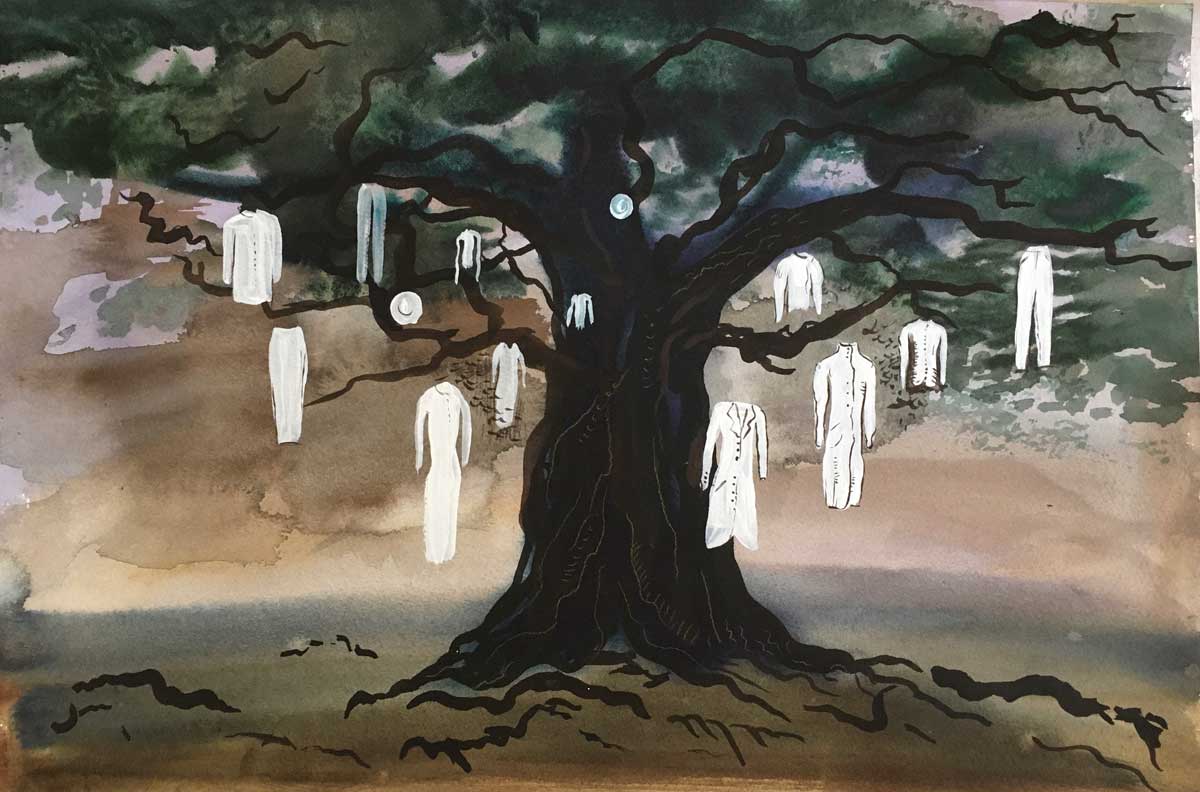
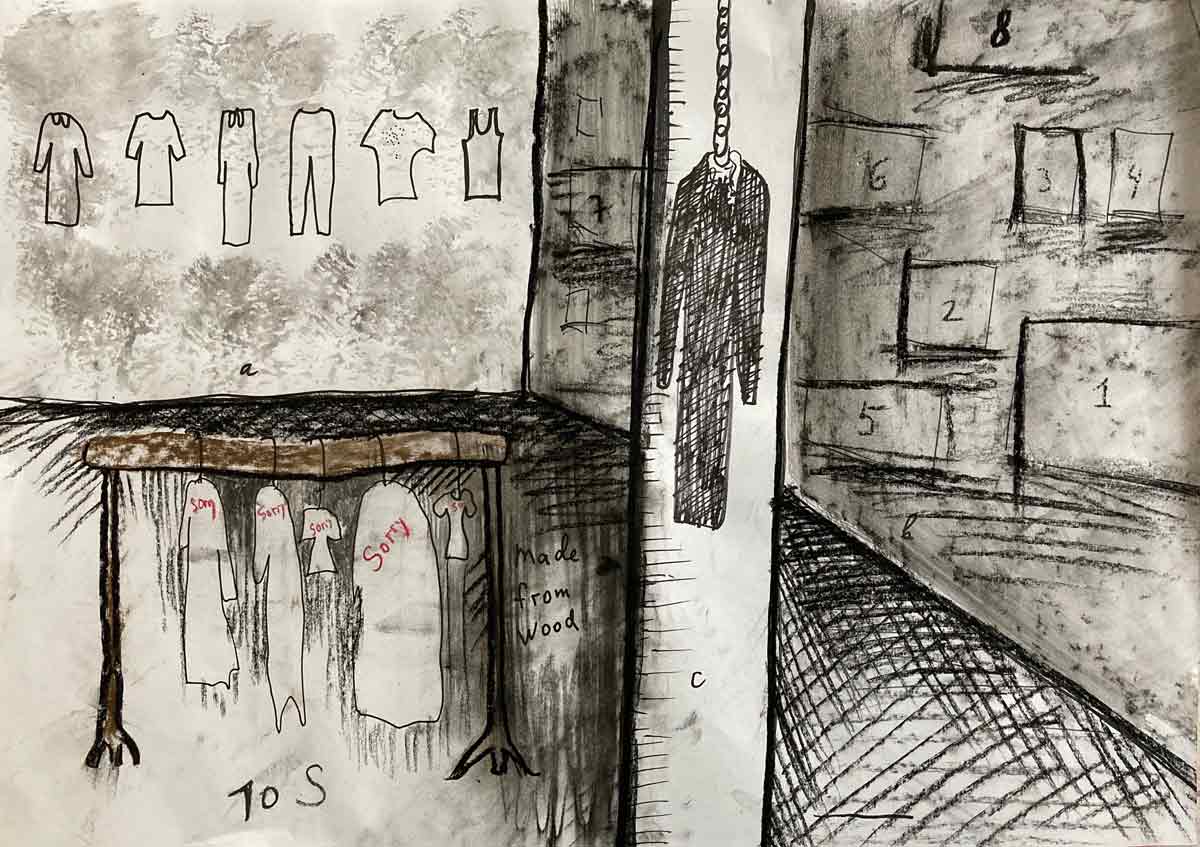
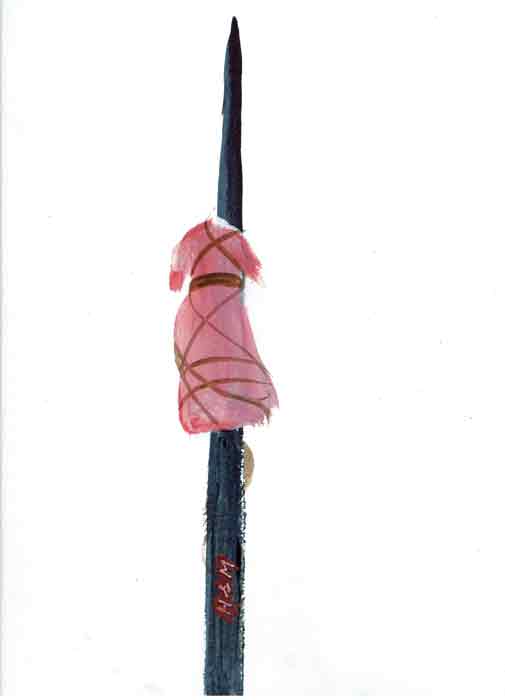

disturbance: witch
Exhibition curated by Alba D’Urbano and Olga Vostretsova
ZAK – Center of Contemporary Art
Spandau Citadel Berlin
Opening reception: Sept 10, 2020, 7 pm
Duration: Sept 11 – Dec 20, 2020
The feminist movement of the 1970s had already made the connection between witches and emancipated women, and the witch became a feminist archetype. Often quoted are the slogans by the Italian feminists, “Tremate, tremate, le streghe sono tornate!” (Tremble, tremble, the Witches have returned!) or “La gioia, la gioia, la si inventa, donna si nasce, le streghe si diventa!” (The joy, the joy, she will be discovered: was born as a woman, became a witch). Sylvia Federici, in her analysis of witch-hunting in connection with the transition from feudalism to capitalism, also describes the solidarity of feminists with witches: “Across ideological differences, the feminists have realized that a hierarchical ranking of human faculties and the identification of women with a degraded conception of corporeal reality has been instrumental, historically, to the consolidation of patriarchal power andthe male exploration of female labor.” (Silvia Federici, Caliban and the Witch: Women, the Body and Primitive Accumulation).
The exhibition disturbance: witch, located at the ZAK (Center for Contemporary Art) of the Spandau Citadel in Berlin, puts into focus disturbing factors that shake deadlocked power relations that are inherent in the character of the witch. The witch, the “abnormal,” the “irrational,” the “magical” and the “inverse” resists rigid role models and structures.
Unfolded within the framework of this international contemporary art exhibition are the aspects of the witch’s character. disturbance: witch does not address the practices of the historical witch nor the practice of magic, rather it analyzes the accompanying attributions to women and queer persons that are used as instruments of exclusion and strategies of a new witch hunt.
Artist list: Jamika Ajalon (US/FR), Emilio Bianchic (AR), Anna und Bernhard Blume (DE), Johanna Braun (AT), Barbara Breitenfellner (AT/DE), Lysann Buschbeck (DE), Alba D’Urbano und Tina Bara (DE), Sarah Decrostoforo (AT), Veronika Eberhardt (AT), Margret Eicher (DE), Parastou Forouhar (IR/DE), Gluklya (Natalia Pershina-Yakimanskaya) (RU/NL), Valerio Fuguccio (IT/DE), Nilbar Güres (TR), Horst Haack (DE), Emily Hunt (AU/DE), Orsi Horváth (HU), Isabel Kerkermeier (DE), Sharon Kivland (GB), Franziska Meinert (DE), Lisl Ponger (AT), Lambert Mousseka (CD/DE), Johannes Paul Raether (DE), Suzanne Treister (GB).